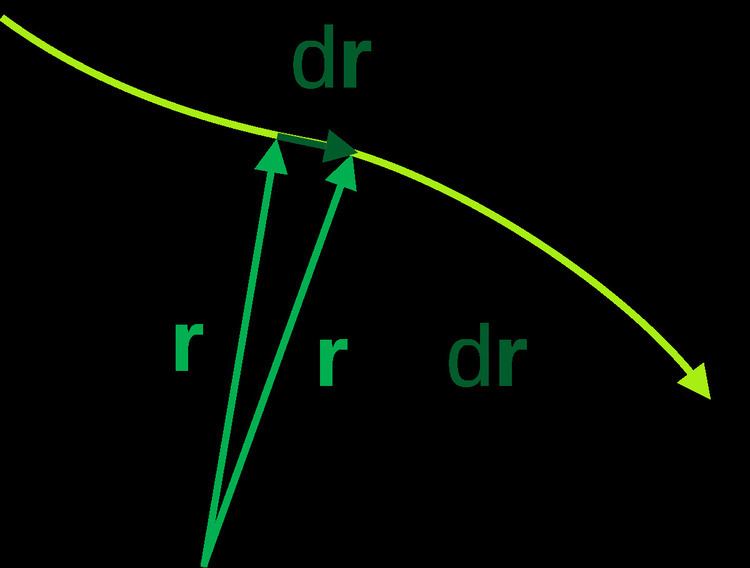 | ||
In geometry, the line element or length element can be informally thought of as a line segment associated with an infinitesimal displacement vector in a metric space. The length of the line element, which may be thought of as a differential arc length, is a function of the metric tensor and is written ds or dℓ.
Contents
- Definition using metric
- Total arc length
- Line elements in Euclidean space
- Cartesian coordinates
- Orthogonal curvilinear coordinates
- General curvilinear coordinates
- Minkowskian spacetime
- General spacetime
- References
Line elements are used in physics, especially in theories of gravitation (most notably general relativity) where spacetime is modelled as a curved Riemannian manifold with a metric tensor.
Definition using metric
The coordinate-independent definition of the square of the line element ds in an n-dimensional metric space is:
where g is the metric tensor, · denotes inner product, and dq an infinitesimal displacement in the metric space.
In n-dimensional general curvilinear coordinates q = (q1, q2, q3, ..., qn), the square of arc length is:
where the indices i and j take values 1, 2, 3, ..., n. Common examples of metric spaces include three-dimensional space (no inclusion of time coordinates), and indeed four-dimensional spacetime. The metric is the origin of the line element, in addition to the surface and volume elements etc.
Total arc length
By parameterizing a curve with a parameter λ, so that q(λ), the arc length of the curve between the points q(λ1) and q(λ2) is the integral:
Line elements in Euclidean space
Following are examples of how the line elements are found from the metric.
Cartesian coordinates
The simplest line element is in Cartesian coordinates - in which case the metric is just the Kronecker delta:
(here i, j = 1, 2, 3 for space) or in matrix form (i denotes row, j denotes column):
The general curvilinear coordinates reduce to Cartesian coordinates:
so
Orthogonal curvilinear coordinates
For all orthogonal coordinates the metric is given by:
where
for i = 1, 2, 3 are scale factors, so the square of the line element is:
Some examples of line elements in these coordinates are below.
General curvilinear coordinates
In general curvilinear coordinates, the metric has elements given by:
so the square of the line element is
Minkowskian spacetime
The Minkowski metric is:
where one sign or the other is chosen, both conventions are used. This applies only for flat spacetime. The coordinates are given by the 4-position:
so the line element is:
General spacetime
The coordinate-independent definition of the square of the line element ds in spacetime is:
In terms of coordinates:
where for this case the indices α and β run over 0, 1, 2, 3 for spacetime.
This is the spacetime interval - the measure of separation between two arbitrarily close events in spacetime. In special relativity it is invariant under Lorentz transformations. In general relativity it is invariant under arbitrary invertible differentiable coordinate transformations.
